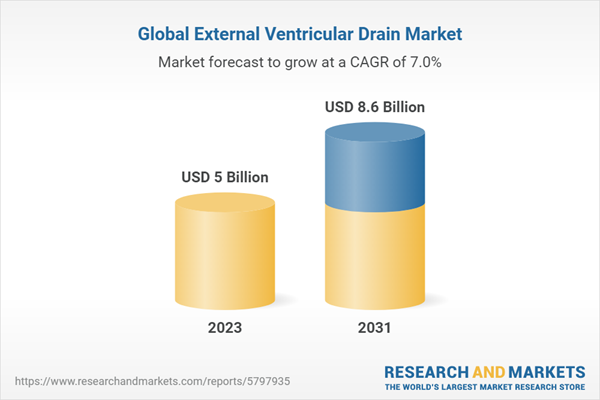External Ventricular Drain Introduction
External ventricular drain (EVD), also known as a ventriculostomy, is a medical device that is used to treat patients who have excess cerebrospinal fluid (CSF) in the brain. The device is used to drain the fluid and relieve pressure in the brain, which can be caused by a variety of conditions such as brain injury, hydrocephalus, or bleeding in the brain.EVDs are typically inserted through a small hole in the skull, allowing a catheter to be passed into the ventricles of the brain. The device is then used to drain excess CSF and monitor intracranial pressure.
The market for EVDs is driven by an increasing incidence of traumatic brain injury and neurological disorders, as well as the growing demand for minimally invasive surgical procedures. The market is expected to continue to grow as new technologies are developed and the demand for neurosurgical procedures increase.
Key trends in the market include the development of new, minimally invasive EVD devices that are easier to use and have fewer complications, as well as the increasing use of EVDs in developing countries where there is a growing demand for neurosurgical services. Additionally, there is a growing trend towards the integration of EVDs with other neurosurgical technologies, such as neuroendoscopy and neurostimulation, to provide more comprehensive treatment options for patients.
External Ventricular Drain Market Scenario
External ventricular drain (EVD), also known as ventriculostomy, is a medical device that is used to manage increased intracranial pressure by draining cerebrospinal fluid (CSF) from the ventricles of the brain. It is a hollow tube that is placed through a hole drilled in the skull into the lateral ventricle, which is the main reservoir for CSF in the brain. EVD is a critical component of neurosurgical procedures, particularly in the management of patients with traumatic brain injuries, intracerebral hemorrhage, or hydrocephalus.The global EVD market is driven by the increasing prevalence of neurodegenerative disorders and traumatic brain injuries, along with the growing geriatric population. The rise in demand for minimally invasive procedures and technological advancements in EVD devices, such as the development of portable and wireless EVD systems, is expected to further boost the market growth. However, the high cost associated with EVD devices and the availability of alternative treatment options may hinder market growth. The EVD market is expected to continue to grow, driven by increasing investments in research and development, expanding healthcare infrastructure, and rising awareness of neurosurgical procedures.
External Ventricular Drain Market Segmentations
Market Breakup by Product
- Ventricular Drainage Set
- Accessories
Market Breakup by Application
- Hydrocephalus
- Reye Syndrome
- Subarachnoid Haemorrhage
- Traumatic Brain Injury
- Others
Market Breakup by End User
- Hospitals
- Specialty Hospitals
- Specialty Clinics
- Others
Market Breakup by Region
North America
- United States of America
- Canada
Europe
- United Kingdom
- Germany
- France
- Italy
- Others
Asia Pacific
- China
- Japan
- India
- ASEAN
- Australia
- Others
Latin America
- Brazil
- Argentina
- Mexico
- Others
Middle East and Africa
- Saudi Arabia
- United Arab Emirates
- Nigeria
- South Africa
- Others
Key Trends in the External Ventricular Drain Market
The key trends in the market for External Ventricular Drain (EVD) include:
- Technological advancements: Advancements in technology have led to the development of more efficient and reliable EVDs that allow for better patient outcomes
- Rising incidence of neurological disorders: The increasing incidence of neurological disorders such as traumatic brain injury, stroke, and hydrocephalus is driving the demand for EVDs
- Growing geriatric population: The elderly population is more susceptible to neurological disorders and requires medical devices such as EVDs for treatment
- Increasing number of neurosurgery procedures: The rising number of neurosurgery procedures has led to an increase in the demand for EVDs in hospitals and clinics
- Improving healthcare infrastructure: The development of healthcare infrastructure in emerging economies has increased access to medical devices such as EVDs, driving market growth
- Rising awareness about neurological disorders: The growing awareness about neurological disorders and the availability of treatment options, including EVDs, is increasing demand for the devices
External Ventricular Drain Market: Competitor Landscape
The key features of the market report include patent analysis, grants analysis, clinical trials analysis, funding and investment analysis, partnerships, and collaborations analysis by the leading key players. The major companies in the market are as follows:- Medtronic plc
- Integra Life Sciences Corporation
- Spiegelberg GmbH & Co. KG
- Zebra Medical
- Neuromedex GmbH
- SOPHYSA
- DISPOMEDICA GMBH
- MÖLLER MEDICAL GMBH
- FUJI SYSTEMS
- B. BRAUN MELSUNGEN AG
Table of Contents
Companies Mentioned
- Medtronic plc
- Integra Life Sciences Corporation
- Spiegelberg GmbH & Co. Kg
- Zebra Medical
- Neuromedex GmbH
- Sophysa
- Dispomedica GmbH
- Möller Medical GmbH
- Fuji Systems
- B. Braun Melsungen Ag
Table Information
| Report Attribute | Details |
|---|---|
| No. of Pages | 140 |
| Published | May 2023 |
| Forecast Period | 2023 - 2031 |
| Estimated Market Value ( USD | $ 5 Billion |
| Forecasted Market Value ( USD | $ 8.6 Billion |
| Compound Annual Growth Rate | 7.0% |
| Regions Covered | Global |
| No. of Companies Mentioned | 10 |









